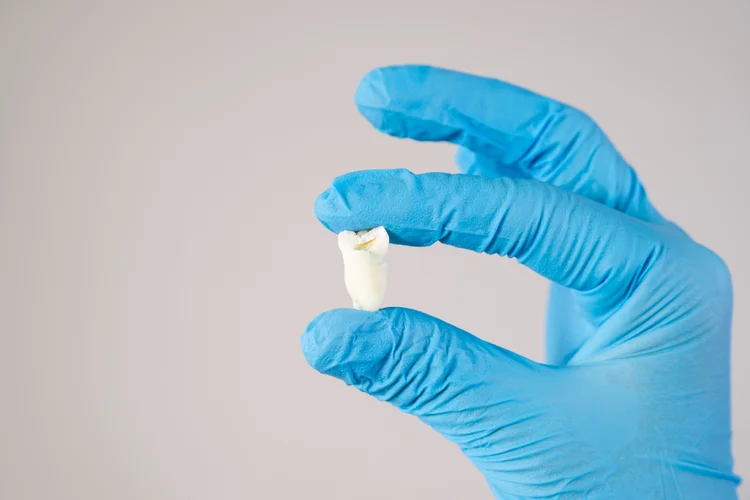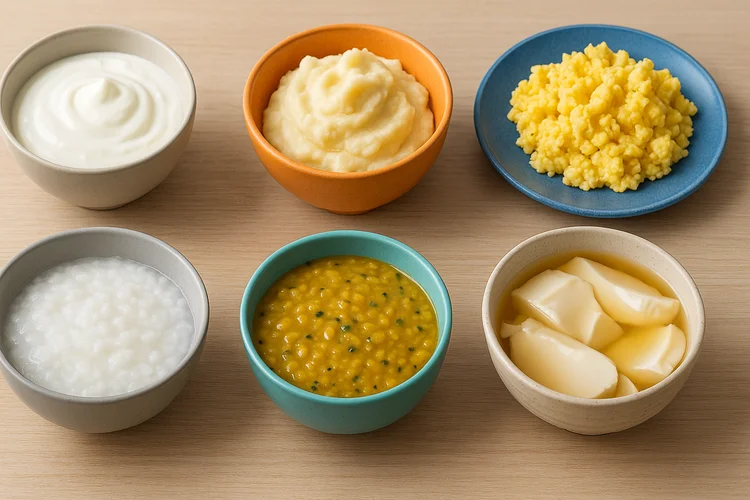If you are preparing for a wisdom tooth extraction or
have recently undergone the procedure, you may be wondering what recovery
involves and how to care for the area properly. While the extraction itself
is typically straightforward, following proper care instructions is
important to minimise discomfort and reduce the risk of
complications.
In this article, we will explain what to expect after the procedure and how
to care for your mouth as it heals, so you can recover with peace of mind
and greater confidence.

Wisdom Tooth Extraction Healing Time
Recovery timelines can vary depending on factors such as the number of teeth
removed, whether the teeth were impacted (stuck beneath the gum or growing at an
angle), and your overall health.
The initial healing period after a wisdom tooth extraction usually takes about 1 to
2 weeks. However, complete healing of the bone and surrounding soft tissues can take
several months.
- Soft tissue, such as the gums around the extraction site, typically closes within 2 to 3 weeks. Mild swelling is common during the first few days and usually subsides within the first week.
- Jawbone remodelling, where the bone reshapes and fills in the empty socket left by the tooth, may take a few months to complete.
- Sutures, or stitches used to help close the wound, are usually removed after 7 to 10 days if they are not dissolvable.
WhatsApp Us Now
Immediate Aftercare Instructions (First 24 Hours)
The first 24 hours after a wisdom tooth extraction are a critical phase of recovery. This period allows the body to form a stable blood clot at the extraction site, which is essential for proper healing and helps prevent complications. You will typically be advised to:
- Bite gently on gauze placed over the extraction site to help control bleeding. Gauze may need to be changed every 30 to 60 minutes, depending on how much bleeding occurs.
- Avoid rinsing, spitting, or using straws, as these actions can disturb the blood clot and delay healing.
- Use a cold compress on the outside of your cheek for 15 minutes at a time to help reduce swelling and discomfort.
- Take pain relief medication such as ibuprofen or paracetamol as prescribed and directed to help manage discomfort and reduce inflammation.
- Keep your head elevated by resting on an extra pillow while lying down, which can help minimise bleeding and swelling.
If bleeding continues for several hours or becomes heavy, it is advisable to contact your dentist or clinic for further guidance.

Oral Hygiene and Cleaning the Extraction Site
Maintaining good oral hygiene after a wisdom tooth extraction helps reduce the risk of infection, but it requires a gentle and cautious approach during the first few days.
- Gently brush the extraction site during the first 24 hours to help maintain cleanliness without disturbing the blood clot.
- Continue brushing the rest of your teeth using a soft-bristled toothbrush using gentle strokes.
- Use mouthwash prescribed by your dentist. An antibacterial rinse such as chlorhexidine may be recommended if there is a higher risk of infection or difficulty keeping the area clean.
- Avoid vigorous rinsing or spitting for the first few days, as this can dislodge the blood clot and delay healing.
Always follow your dentist’s instructions, as care may vary based on your individual case.
Eating and Drinking After Wisdom Tooth Extraction
During recovery, it is important to eat and drink in a way that protects the extraction site and avoids anything that may irritate the area or dislodge the blood clot, to support healing.
- Stick to soft, non-irritating foods for the first few days, such as yoghurt, mashed potatoes, scrambled eggs, porridge or bubur, dhal with soft rice, tau huay (soybean pudding), and soft kway teow soup.
- Avoid hot, spicy, acidic, crunchy, or chewy foods, as these may irritate the surgical site or become trapped in the socket.
- Avoid drinking through a straw for at least one week, as suction can dislodge the blood clot and delay healing.
- Stay well hydrated, but limit yourself to lukewarm or cool water during the first 24 hours. Avoid caffeinated or alcoholic drinks, as they may increase bleeding, delay clot formation, or cause dehydration.
As healing progresses, you can gradually reintroduce firmer foods based on your comfort level and your dentist’s advice.

Activities and Things to Avoid During Recovery
Certain activities can interfere with healing or increase the risk of complications. It is important to:
- Refrain from touching or probing the extraction site with your tongue, fingers, or any objects, as this can disturb the blood clot and delay healing.
- Avoid strenuous physical activity, including exercise or heavy lifting, for 2 to 3 days after the extraction, as it can increase blood pressure and dislodge the blood clot.
- Avoid smoking for at least 7 days, as it slows down healing and significantly increases the risk of dry socket, and preferably avoid it for as long as possible during recovery.
Recognising Signs of Complications
Although complications are uncommon, it is important to recognise signs that may indicate a problem requiring further attention.
- Dry socket – A dull, throbbing pain that begins a few days after the extraction, often with an unpleasant taste or odour. It occurs when the blood clot is dislodged or fails to form, exposing the bone and delaying healing.
- Infection – Swelling that worsens after five days, fever, pus discharge, or increasing pain. These may signal a bacterial infection that can slow healing or spread if untreated.
- Nerve involvement – Numbness or tingling in the lips, tongue, or chin that lasts beyond a few days. This may result from temporary or, less commonly, prolonged nerve irritation during extraction.
If you experience any of these symptoms, it is important to contact your dentist for prompt evaluation.

Book a Wisdom Tooth Consultation With Our Friendly Dentists Today!
Book Wisdom Tooth Appointment
Book NowEnquire More Through Email
Email Us NowEnquire More Through WhatsApp
WhatsApp Us NowWhy Choose True Dental Studio?
Friendly Dentist and Team
Our team treats each and every patient to the best of our ability. This is the reason why entire families have continued their dental care with True Dental Studio for many years, from all over Singapore.
Minimal Discomfort
At True Dental, it is our commitment to ensure our patients are kept as comfortable as possible. We aim to minimize discomfort, if any, for our patients.
Affordable Treatments
We believe in pricing quality treatments at a competitive rate. We are transparent and upfront with our treatment costs.
Our Smile Scorecard
Frequently Asked Questions
Pain after wisdom tooth extraction can be managed with prescribed or over-the-counter pain relief such as ibuprofen or paracetamol. Applying cold compresses during the first 24 hours can help reduce swelling and discomfort. Limiting physical activity may also support recovery. If pain worsens or does not improve after a few days, it is advisable to consult your dentist, as it may indicate an underlying issue such as infection or dry socket.
Pain typically peaks within the first 48 hours and gradually subsides over the next few days. Most people experience noticeable improvement within 3 to 5 days, though some discomfort may persist for up to a week. If pain intensifies after three days or does not improve, it may indicate a complication. It is advisable to consult your dentist if symptoms do not follow the expected recovery timeline.
Mouthwash should only be used after a wisdom tooth extraction if prescribed by your dentist. For example, in higher-risk cases, an antibacterial rinse such as chlorhexidine may be recommended to reduce bacterial buildup. Using commercial or alcohol-based mouthwashes without guidance may irritate the extraction site or interfere with healing. It is advisable to follow your dentist’s instructions based on your specific recovery needs.
You can usually talk after wisdom tooth extraction, but it is best to limit speaking as much as possible on the first day. Excessive movement of the jaw may strain the surgical area or disturb the blood clot, especially if multiple teeth were removed. Speaking gently and minimally during the first 24 hours supports healing and reduces the risk of complications.
Yes, you can eat after wisdom tooth extraction, but it is recommended to wait until the numbness wears off to avoid biting your cheek or tongue. Stick to soft, cool foods that do not require chewing, and avoid anything hot, spicy, or crunchy. Gradually return to a normal diet based on comfort and healing progress. It is advisable to follow your dentist’s specific dietary recommendations.
The socket left after a wisdom tooth extraction usually begins to close within a few weeks as soft tissue heals, although full bone healing may take several months. If the hole remains open or continues to trap food over time, it may cause irritation or increase the risk of infection. It is advisable to consult your dentist during follow-up appointments to assess whether further care is needed.
You can brush your teeth after wisdom teeth removal, but avoid the extraction site for the first 24 hours to allow the blood clot to stabilise. Continue brushing the rest of your mouth with a soft-bristled toothbrush using gentle strokes. Most people can resume brushing near the extraction site after 3 to 5 days, depending on healing. It is advisable to follow your dentist’s instructions for when and how to resume full oral hygiene.
Most people need about 1 to 3 days of rest after wisdom teeth removal, though this can vary depending on the number of teeth removed and the complexity of the procedure. While you may return to normal activities after a few days, strenuous physical exertion should be avoided for at least 2 to 3 days to reduce the risk of complications. It is advisable to consult your dentist if recovery takes longer than expected.
The fastest way to recover from wisdom teeth removal is to protect the blood clot at the extraction site, as it is essential for healing and reducing complications. This typically involves getting adequate rest, maintaining proper oral hygiene, eating soft foods, and avoiding straws or strenuous activity. Recovery times vary between individuals, so it is advisable to consult your dentist if symptoms worsen or do not improve as expected.
Day 3 after wisdom tooth removal is often when swelling and inflammation peak, which can make discomfort feel more noticeable. This is a normal part of the body’s healing response and typically resolves over the next few days. Pain and swelling should gradually decrease from day 4 onward. If symptoms intensify or do not improve after this period, it is advisable to consult your dentist to rule out complications.
You can begin eating once the numbness wears off, typically a few hours after surgery, to avoid accidentally biting your cheek or tongue. Start with soft, cool foods that require minimal chewing and avoid anything hot, spicy, or crunchy. Most people can reintroduce firmer foods gradually over several days. It is advisable to follow your dentist’s specific dietary guidance based on your healing progress and individual case.
Spitting too soon after wisdom tooth extraction can dislodge the blood clot and increase the risk of dry socket. If you accidentally spit once, it may not cause harm, but repeated or forceful spitting in the first 24 to 48 hours can delay healing. If you experience new or worsening pain following this, it is advisable to consult your dentist to determine if further care is needed.
The risk of dry socket is usually highest between 2 to 5 days after wisdom tooth extraction. By the end of the first week, the blood clot typically stabilises and the risk begins to decrease. However, healing timelines vary, and certain factors may prolong risk. It is advisable to consult a dentist if you develop new pain, bad breath, or a bad taste several days after the procedure.
Top wisdom teeth generally heal faster than bottom ones because lower extractions are more likely to involve bone removal or deeper impaction, where the tooth is partially or fully trapped in the jawbone or gum. However, healing time also depends on individual anatomy, surgical complexity, and overall health. Bottom extractions may be more prone to swelling and discomfort.
The third day after wisdom tooth extraction is often the most painful as inflammation and swelling typically peak at this stage. This is a normal part of the healing process and usually begins to improve from the fourth day onward. While discomfort varies between individuals, pain that worsens or persists beyond this period may indicate a complication. It is advisable to consult your dentist for further evaluation.
